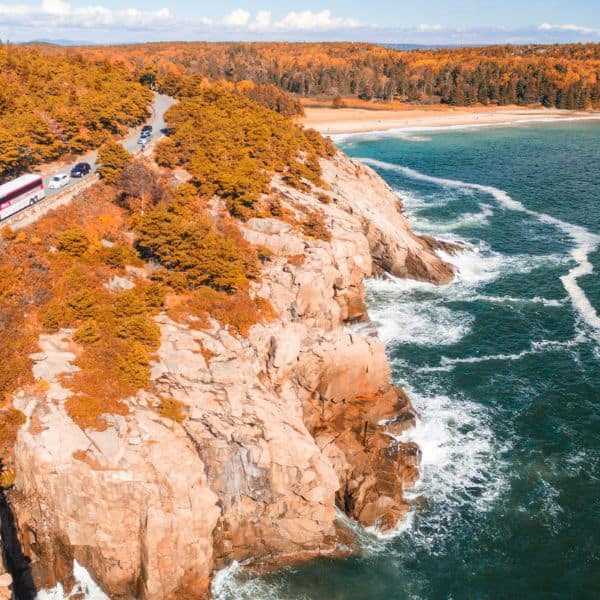
Acadia National Park is a stunning natural wonderland located on the coast of Maine. It is a popular destination for outdoor enthusiasts, offering everything from hiking and camping to whale watching and rock climbing. But the history of Acadia National Park is just as fascinating as its natural beauty.
Acadia National Park was first established as Sieur de Monts National Monument in 1916 by President Woodrow Wilson. It was the first national park east of the Mississippi River, and only the second in the country to be established on land donated by private citizens. The park’s early years were marked by political struggles and financial difficulties, but through the hard work of dedicated conservationists and park officials, Acadia National Park has grown into one of the most popular national parks in the United States.
The history of Acadia National Park is closely tied to the history of Mount Desert Island, where the park is located. The island has a rich cultural and natural history, with evidence of human habitation dating back over 5,000 years. The Wabanaki people, who were the first to call the island home, have a deep spiritual connection to the land, and their traditions and stories continue to be an important part of the island’s cultural heritage.
In the 1600s, European settlers began to arrive on Mount Desert Island, and by the early 1900s, the island had become a popular summer resort destination for wealthy families from the Northeast. The island’s rugged coastline, pristine forests, and scenic mountains attracted artists and writers, who were drawn to the island’s natural beauty and sense of peace.
In 1901, wealthy philanthropist George B. Dorr began to acquire land on Mount Desert Island with the goal of preserving its natural beauty for future generations. Dorr believed that the island’s unique landscape was worthy of protection, and he wanted to create a national park that would ensure its preservation for generations to come.
Dorr’s efforts were supported by several other influential conservationists, including John D. Rockefeller Jr., who donated millions of dollars to help purchase land for the park. Despite the support of these influential individuals, the creation of a national park on Mount Desert Island was not without controversy.
Many of the island’s wealthy residents were opposed to the creation of a national park, fearing that it would restrict their access to the land and interfere with their private estates. Some also saw the creation of a national park as a threat to their social status, as it would attract tourists and development to the island.
In the face of opposition, Dorr and his supporters continued to work tirelessly to create a national park on Mount Desert Island. They lobbied Congress, raised funds, and enlisted the help of influential politicians and conservationists to support their cause.
Their efforts paid off in 1916, when President Woodrow Wilson signed a proclamation establishing Sieur de Monts National Monument on Mount Desert Island. The monument was later renamed Lafayette National Park in honor of the Marquis de Lafayette, the French general who helped the United States win its independence from Britain.
Over the next few years, the park continued to grow and evolve. In 1929, the park’s name was changed to Acadia National Park, reflecting the strong ties between the park and the cultural and natural history of the Acadian people who once lived in the area.
During the Great Depression, the Civilian Conservation Corps (CCC) was tasked with improving and expanding the park’s facilities. The CCC built roads, trails, campsites, and other amenities, making the park more accessible to visitors from all walks of life.
Today, Acadia National Park covers over 49,000 acres of land and water, and welcomes millions of visitors each year. The park is home to an incredible variety of plants and animals, including moose, black bears
Related posts:
Acadia National Park is located on the rugged east coast. It is more commonly known as "mountain national park". It's one of thr top tourist attractions. Among its natural wildlife are moose, bears, whales and seabird-folks alike. In fact, the baysid...
Acadia National Park, located on Mount Desert Island in Maine, is known for its rugged coastline, towering mountains, and pristine forests. It is a hiker's paradise, with over 120 miles of trails that offer breathtaking views of t...
Acadia National Park is Canada's largest national park. It is also one of its most remote. It is located on the east coast of Nova Scotia, on the ridge above Soufriere, New Brunswick. It is sometimes referred to as Three Sisters because of the many ...
Acadia National Park, located on the coast of Maine, is a paradise for outdoor enthusiasts. With over 120 miles of hiking trails, beautiful lakes and coastline, and campsites scattered throughout the park, Acadia National Park is the perfect dest...
Acadia National Park is an unspoiled natural coastal region mainly in Maine. It is noted for its mountainous terrain, wooded forests, abundant wildlife and spectacular marine life. It was one of the last continents to be discovered by European explor...
Acadia National Park in Maine is a beautiful destination for hikers of all levels, with over 120 miles of trails winding through rugged coastlines, dense forests, and stunning mountains. Whether you're a seasoned hiker or just startin...